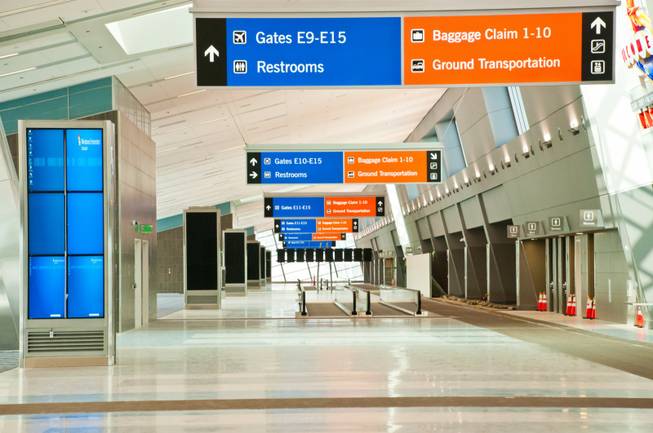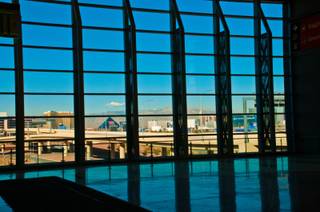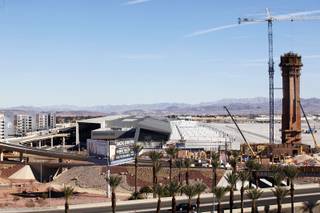Thursday, Feb. 16, 2012 | 2 a.m.
Sun coverage
I have seen the future, and it’s at McCarran International Airport’s Terminal 3.
Not only is it going to become a gateway to Las Vegas that local residents will be proud of, but it’s being built with the expansion and contraction of the fluid airline industry in mind.
There’s still plenty of work to do at the $2.4 billion building that officially opens June 27, but Randall Walker, director of the Clark County Aviation Department, took me on a two-hour tour of the place recently and probably got tired of hearing me say, “Wow!” at every turn.
If you’re a regular user of McCarran, there will be a learning curve involved in where to go when the new terminal opens. But it shouldn’t be too steep, and Walker has promised some public familiarization events prior to the opening.
If you’re one of the many customers of Southwest Airlines, your path to the airport won’t change — the airport’s busiest carrier is staying put at the C and B gates.
The biggest pluses of T3 are that it will lead to the closure of Terminal 2, the outdated international and charter facility on the north end of the main airport complex, and will take pressure off of Terminal 1, the facility where passengers depart on almost all domestic flights.
All the international traffic will shift to T3 when the doors open, and those carriers will take up residence on the east end of the half-mile-long building.
By the end of July, seven domestic carriers will set up on the west end of the building — Alaska, Frontier, JetBlue, Virgin America, Sun Country, Hawaiian and United.
By the end of August, passengers will go to T3 if their flights leave from the D gates — and that’s where the learning curve comes in. McCarran will try to ease the stress by installing several dynamic signs along roads heading into the airport that will identify which airline passengers should go to T3 and which would go to the existing Terminal 1.
The signs will have changeable messages, not because McCarran is going to swap things out overnight but because the airline industry itself is in constant flux. In just the last decade; United and Continental became United; Delta and Northwest became Delta; Southwest began swallowing AirTran; and Mexicana, ATA, Aloha and Maxjet disappeared.
Information will be everywhere at T3, thanks to FIDS and BIDS. (Where would aviation be without all kinds of acronyms?) Thanks to McCarran’s decision years ago to use common-use technology, there will be screens throughout the terminal on the Flight Information Displays System and in the baggage claim area for the Baggage Information Displays System.
The counter areas of T3 have miles of electrical and communications plumbing and hundreds of mini-manholes called “turtles” that will allow airlines to expand and contract their counter space with ease. McCarran has accounted for space and self-use scales for the eventual introduction of the self-tagging of bags, which already is done in Amsterdam and Montreal.
The counters will be on the ends, and all the passenger traffic will flow to the center of the eye-pleasing linear building, where the Transportation Security Administration checkpoints will be in place. When it opens, the TSA will be on the same level as the ticket counters, and there’s space for 14 security lanes.
There also will be a checkpoint a level down for 17 lanes, which could be used as traffic grows and to scan passengers headed for the D gates on a tram shuttle similar to the ones that carry passengers from the main terminal to the C and D gates. The tram track will be about the same length as the one that links the main terminal to the C gates and will dock at the D gates rotunda, where a retail area is planned.
There are 14 gates numbered 1E-15E (no Gate 13E), and there will be some flexibility for domestic and international use at 7E. Some of the international gates will have dual passenger bridges for faster loading and unloading of jumbo jets.
Opening and closing a series of glass doors will form a corridor for arriving international arrivals where a maximum of 28 lanes will be available to check passports and entry documents.
There are 15 baggage carousels spread along the length of the terminal to accommodate arrivals. There will be a short walk to the curb for pickups and taxi service. The cab loading area has 20 spots, and it’s expandable. Those spots are in addition to the ones at Terminal 1 that will remain open.
There will be a shaded taxi waiting area for cabbies, and the 6,000-space parking garage should be more than enough to accommodate people on most days.
Ingress and egress will be easy — blue signs direct departing passengers and orange signs guide arrivals.
Walker is planning a public day in June with free parking for locals to familiarize themselves with the terminal, and a charitable 10K run is planned on the network of T3 roadways for people to explore the road system on foot before it opens to vehicles.





Join the Discussion:
Check this out for a full explanation of our conversion to the LiveFyre commenting system and instructions on how to sign up for an account.
Full comments policy